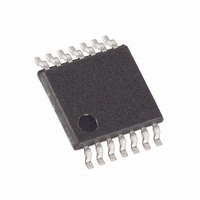MAX4454EUD+ Maxim Integrated Products, MAX4454EUD+ Datasheet - Page 11

MAX4454EUD+
Manufacturer Part Number
MAX4454EUD+
Description
IC OP AMP R-R SS 14-TSSOP
Manufacturer
Maxim Integrated Products
Datasheet
1.MAX4352EXKT.pdf
(19 pages)
Specifications of MAX4454EUD+
Amplifier Type
Voltage Feedback
Number Of Circuits
4
Output Type
Rail-to-Rail
Slew Rate
95 V/µs
-3db Bandwidth
200MHz
Current - Input Bias
800nA
Voltage - Input Offset
400µV
Current - Supply
620µA
Current - Output / Channel
22mA
Voltage - Supply, Single/dual (±)
2.7 V ~ 5.25 V
Operating Temperature
-40°C ~ 85°C
Mounting Type
Surface Mount
Package / Case
14-TSSOP
Number Of Channels
4
Voltage Gain Db
80 dB
Common Mode Rejection Ratio (min)
60 dB
Input Offset Voltage
0.4 mV
Operating Supply Voltage
3 V, 5 V
Maximum Power Dissipation
500 mW
Maximum Operating Temperature
+ 85 C
Mounting Style
SMD/SMT
Minimum Operating Temperature
- 40 C
Lead Free Status / RoHS Status
Lead free / RoHS Compliant
Gain Bandwidth Product
-
Lead Free Status / Rohs Status
Details
The MAX4452/MAX4352 single, MAX4453/MAX4353
dual, and MAX4454/MAX4354 quad, single-supply, rail-
to-rail, voltage-feedback amplifiers achieve high slew
rates and wide bandwidths while consuming only
620µA per amplifier. Excellent speed/power ratio
makes them ideal for portable devices and high-fre-
quency signal applications.
Internal feedback around the output stage ensures low
open-loop output impedance, reducing gain sensitivity
to load variations. This feedback also produces
demand-driven current bias to the output transistors.
The input common-mode range extends from (V
0.1V) to (V
rejection. Beyond this range, the amplifier output is a
nonlinear function of the input, but does not undergo
phase reversal or latchup.
The output swings to within 180mV of either power-sup-
ply rail with a 1kΩ load. The input ground-sensing and
the rail-to-rail output substantially increase the dynamic
range.
The MAX4452/MAX4453/MAX4454/MAX4352/MAX4353/
MAX4354 are optimized for AC performance. They are
not designed to drive highly reactive loads. Such loads
decrease phase margin and may produce excessive
ringing and oscillation. The use of an isolation resistor
eliminates this problem (Figure 1). Figure 2 is a graph
of the Optimal Isolation Resistor (R
Load.
The MAX4452/MAX4453/MAX4454 are internally com-
pensated for unity gain. When configured for unity gain,
a 24Ω feedback resistor (R
resistor improves AC response by reducing the Q of
the parallel LC circuit formed by the parasitic feedback
capacitance and inductance.
Select the gain-setting feedback (R
resistor values that best fit the application. Large resis-
tor values increase voltage noise and interact with the
amplifier’s input and PC board capacitance. This can
generate undesirable poles and zeros and decrease
bandwidth or cause oscillations. For example, a nonin-
verting gain-of-two configuration (R
Rail-to-Rail Outputs, Ground-Sensing Input
Single-Supply Op Amps with Rail-to-Rail Outputs
Output Capacitive Loading and Stability
Inverting and Noninverting Configurations
CC
- 1.5V) with excellent common-mode
Applications Information
______________________________________________________________________________________
Choosing Resistor Values
Detailed Description
Unity-Gain Configuration
F
) is recommended. This
Low-Cost, +3V/+5V, 620µA, 200MHz,
ISO
F
F
= R
) and input (R
) vs. Capacitive
G
) using 1kΩ
EE
G
-
)
resistors, combined with 2pF of amplifier input capaci-
tance and 1pF of PC board capacitance, causes a pole
at 106MHz. Since this pole is within the amplifier band-
width, it jeopardizes stability. Reducing the 1kΩ resis-
tors to 100Ω extends the pole frequency to 1.06GHz,
but could limit output swing by adding 200Ω in parallel
with the amplifier’s load resistor.
Note: For high-gain applications where output offset
voltage is a consideration, choose RS to be equal to
the parallel combination of RF and RG (Figures 3a and
3b).
Figure 1. Driving a Capacitive Load Through an Isolation
Resistor
Figure 2. Optimal Isolation Resistor vs. Capacitive Load
3b):
30
28
26
24
22
20
18
16
14
12
10
R
V
G
IN
0
R
BIN
R
ISOLATION RESISTANCE
S
vs. CAPACITIVE LOAD
50
=
R F
C
R F R G
LOAD
R
F
×
+
(pF)
R G
100
R
ISO
150
C
V
L
OUT
11










